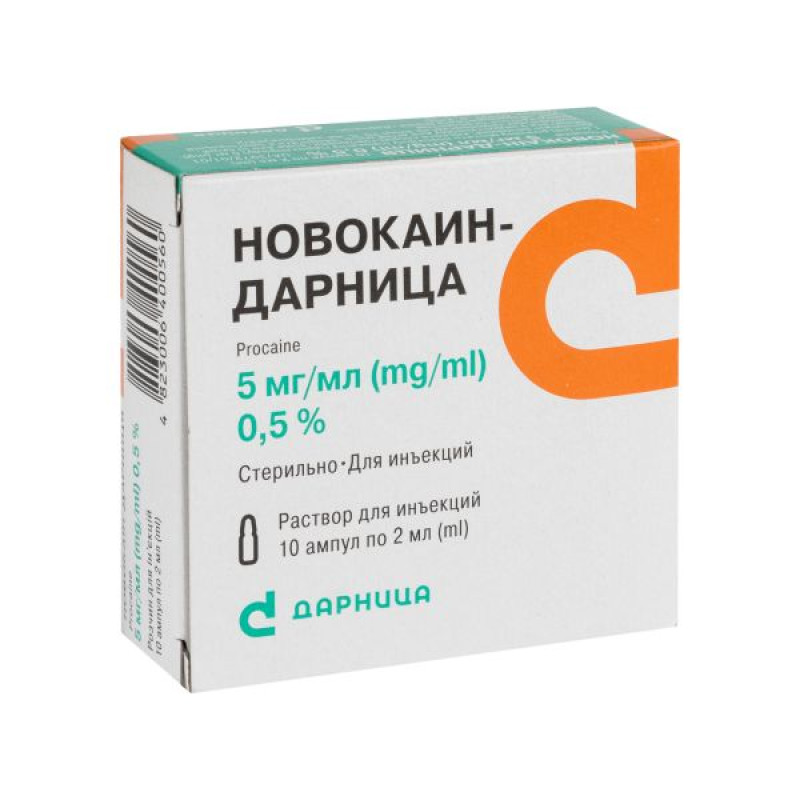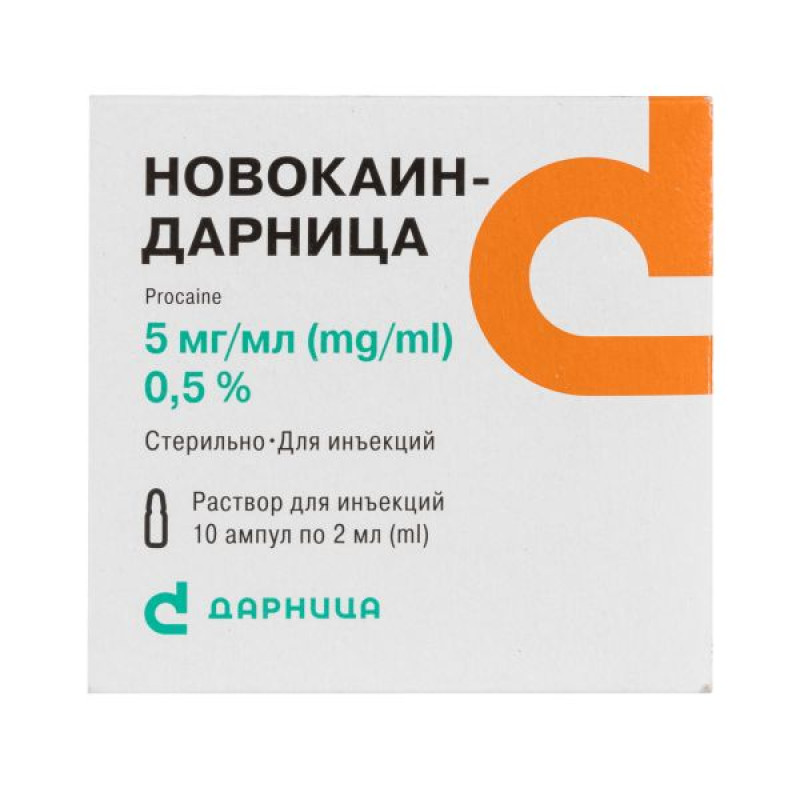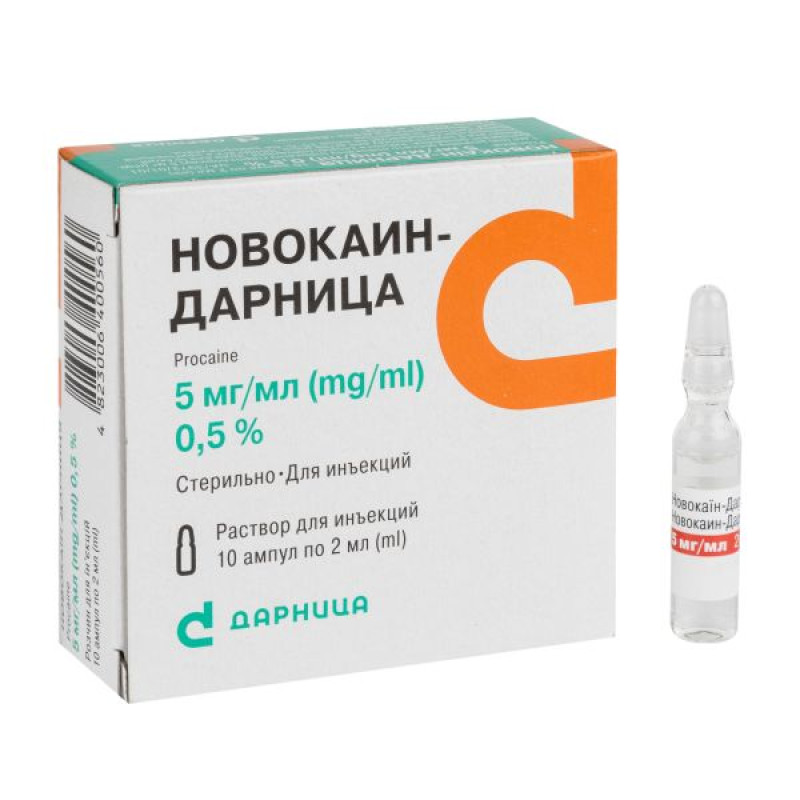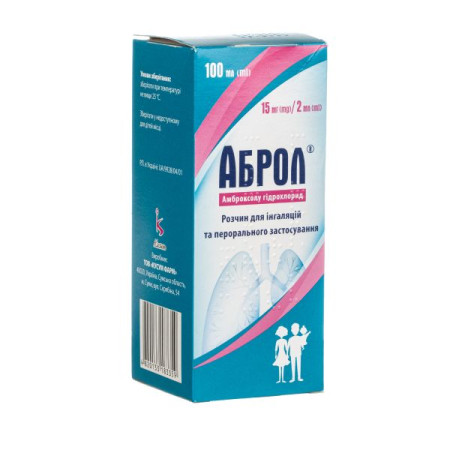Novocaine-Darnitsa solution for injection 5 mg/ml ampoule 2 ml No. 10

Novocain-Darnitsa injection solution is indicated for local and infiltration anesthesia, therapeutic blockades.
Composition
Active ingredient: procaine;
1 ml of solution contains novocaine (procaine hydrochloride) 5 mg;
Excipients: hydrochloric acid, water for injections.
Contraindication
Increased individual sensitivity to the drug.
Myasthenia gravis, arterial hypotension, purulent process at the injection site, urgent surgical interventions accompanied by acute blood loss, pronounced fibrous changes in tissues (for anesthesia by the method of creeping infiltrate).
Method of application
With local anesthesia, the dose of the drug depends on the concentration, nature of the surgical intervention, method of administration, condition and age of the patient. With paranephral blockade, 50-70 ml of 0.5% (5 mg/ml) Novocaine solution is injected into the pararenal tissue in adults.
For infiltration anesthesia, the following higher doses are established (for adults): the first single dose at the beginning of the operation is 0.75 g (i.e. 150 ml of 0.5% novocaine solution); subsequently, during each hour of the operation, no more than 2 g (i.e. 400 ml of 0.5% novocaine solution).
Application features
Pregnant women
Use during pregnancy is possible provided it is well tolerated.
Children
Children are prohibited from using it.
Drivers
During the treatment period, caution should be exercised when driving vehicles and engaging in other potentially dangerous activities that require increased concentration and speed of psychomotor reactions.
Overdose
Symptoms: pallor of the skin and mucous membranes, dizziness, nausea, vomiting, increased nervous excitability, cold sweat, tachycardia, decrease in blood pressure almost to the point of collapse, tremor, convulsions, apnea, methemoglobinemia, respiratory depression, sudden cardiovascular collapse.
The effect on the central nervous system is manifested by a feeling of fear, hallucinations, convulsions, motor agitation. In cases of overdose, the administration of the drug should be stopped immediately. When performing local anesthesia, the injection site can be pricked with adrenaline.
Treatment: general resuscitation measures, including oxygen inhalation, if necessary - artificial ventilation of the lungs. If convulsions last more than 15-20 seconds, they are eliminated by intravenous administration of thiopental (100-150 mg) or diazepam (5-20 mg). With hypotension and / or myocardial depression, ephedrine (15-30 mg) is administered intravenously, in severe cases - detoxification and symptomatic therapy.
In the event of intoxication after injection of novocaine into the muscles of the leg or arm, urgent application of a tourniquet is recommended to reduce further entry of the drug into the general bloodstream.
Side effects
From the central and peripheral nervous system: headache, dizziness, drowsiness, weakness, motor restlessness, loss of consciousness, convulsions, trismus, tremor, visual and auditory disturbances, nystagmus, cauda equina syndrome (paralysis of the legs, paresthesias), paralysis of the respiratory muscles, motor and sensory block, return of pain, persistent anesthesia. From the cardiovascular system: increase or decrease in blood pressure, peripheral vasodilation, collapse, bradycardia, arrhythmias, chest pain. From the urinary system: involuntary urination. From the digestive system: nausea, vomiting, involuntary defecation. From the blood system: methemoglobinemia. Allergic reactions: skin itching, rash, dermatitis, skin peeling, other anaphylactic reactions (including angioedema, anaphylactic shock), urticaria (on the skin and mucous membranes). Others: hypothermia.Interaction
When treating the injection site of a local anesthetic with disinfectant solutions containing heavy metals, the risk of developing a local reaction in the form of soreness and swelling increases. Potentiates the effect of direct anticoagulants.
The drug reduces the effect of anticholinesterase agents on neuromuscular transmission. Cross-sensitization is possible.
Storage conditions
Store in the original packaging at a temperature not exceeding 25 °C.
Keep out of reach of children.
Shelf life - 3 years.
There are no reviews for this product.
There are no reviews for this product, be the first to leave your review.
No questions about this product, be the first and ask your question.











